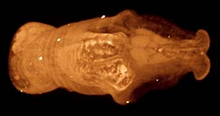Aplacophora
| Aplacophora | |
|---|---|

| |
| Head region of the caudofoveate Falcidens | |
| Scientific classification | |
| Domain: | Eukaryota |
| Kingdom: | Animalia |
| Phylum: | Mollusca |
| Class: | Aplacophora |
| Included groups | |
Aplacophora
All known modern forms are shell-less: only some extinct primitive forms possessed valves. The group comprises the two clades Solenogastres (Neomeniomorpha) and Caudofoveata (Chaetodermomorpha), which between them contain 28 families and about 320 species. The aplacophorans are traditionally considered ancestral to the other mollusc classes. However, the relationship between the two aplacophoran groups and to the other molluscan classes and to each other is as yet unclear.
Aplacophorans are cylindrical and worm-like in form, and most very small, being no longer than 5 centimetres (2 in); some species, however, can reach a length of 30 centimetres (12 in).
Habitat
Caudofoveates generally burrow into the
Description

Aplacophorans are worm-like animals, with little resemblance to most other molluscs. They have no
The relationship with other molluscs, however, is apparent from some features of the digestive system; aplacophorans possess both a radula and a style. A variety of radular forms and functions exist.[11] Solenogasters are hermaphroditic and assumed to have internal fertilization, in contrast to caudofoveates which have two sexes, and reproduce by external fertilization. During development, the mantle cavity of the larva curls up and closes, creating the worm-like form of the adult.[4] Caudofoveates also differ from Solenogasters in having a head shield and a body that is differentiated into three sections.[12]
Taxonomy and evolution
This class was once classified as
The affinities of Aplacophorans have long been uncertain. Molecular and fossil evidence seemed to put Aplacophorans in the clade
References
- ^ MolluscaBase eds. (2021). MolluscaBase. Aplacophora. Accessed through: World Register of Marine Species at: http://www.marinespecies.org/aphia.php?p=taxdetails&id=411 on 2021-04-13
- S2CID 85911879.
- ^ Haas, Winfried (1981). "Evolution of calcareous hardparts in primitive molluscs". Malacologia. 21: 403–418.
- ^ ISBN 978-0-03-056747-6.
- .
- ^ S2CID 15935925.
- S2CID 135492113.
- ^ "The Aplacophoran Family Prochaetodermatidae in the North American Basin, Including Chevroderma N.G. and Spathoderma N.G. (Mollusca; Chaetodermomorpha)*". Retrieved 7 June 2013.
{{cite journal}}: Cite journal requires|journal=(help) - S2CID 28029055.
- PMID 20181015.
- .
- ^ Biology and Evolution of the Mollusca
- PMID 16675549.
- ^ PMID 21892190.
- ^ S2CID 4321076.
- PMID 17652065. For a summary, see "The Mollusca". University of California Museum of Paleontology. Retrieved 2 October 2008.
- PMID 29300613.
- PMID 21976685.
- S2CID 4422386.
